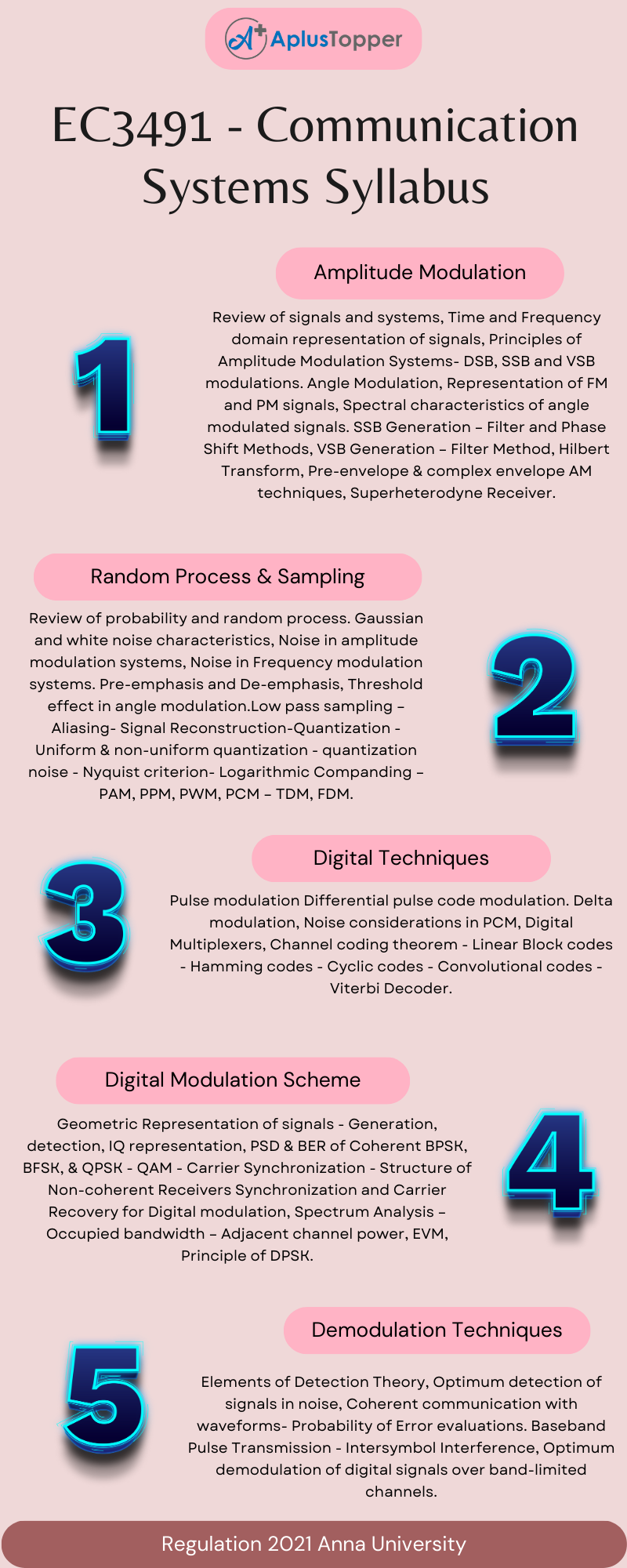Code EC3491 deals with the subject from the Anna University Regulation 2021, related to affiliated institutions, syllabus of B.E Electronics and Telecommunication Engineering. In this article, we discuss the Communication Systems Syllabus.
We intend to provide the syllabus of EC3491 – Communication Systems, we include the textbooks and references from the faculty of experts. You can get the required information unit-wise. The following links will help you to get proper information. I hope you can find the details in the article given below.
If you want to know more about the syllabus of B.E Computer Science and Engineering (Cyber security) Syllabus connected to an affiliated institution’s four-year undergraduate degree program. We provide you with a detailed Year-wise, semester-wise, and Subject-wise syllabus in the following link B.E Electronics and Telecommunication Engineering Syllabus Anna University, Regulation 2021.
Aim of Objectives:
- To introduce Analog Modulation Schemes.
- To impart knowledge in random process.
- To study various Digital techniques.
- To introduce the importance of sampling & quantization.
- To impart knowledge in demodulation techniques.
- To enhance the classroom teaching using smart connectivity instruments.
EC3491 – Communication Systems Syllabus
Unit – I: Amplitude Modulation
Review of signals and systems, Time and Frequency domain representation of signals, Principles of Amplitude Modulation Systems- DSB, SSB and VSB modulations. Angle Modulation, Representation of FM and PM signals, Spectral characteristics of angle modulated signals. SSB Generation – Filter and Phase Shift Methods, VSB Generation – Filter Method, Hilbert Transform, Pre-envelope & complex envelope AM techniques, Superheterodyne Receiver.
Unit – II: Random Process & Sampling
Review of probability and random process. Gaussian and white noise characteristics, Noise in amplitude modulation systems, Noise in Frequency modulation systems. Pre-emphasis and De-emphasis, Threshold effect in angle modulation.Low pass sampling – Aliasing- Signal Reconstruction-Quantization – Uniform & non-uniform quantization – quantization noise – Nyquist criterion- Logarithmic Companding –PAM, PPM, PWM, PCM – TDM, FDM.

Unit – III: Digital Techniques
Pulse modulation Differential pulse code modulation. Delta modulation, Noise considerations in PCM,, Digital Multiplexers, Channel coding theorem – Linear Block codes – Hamming codes – Cyclic codes – Convolutional codes – Viterbi Decoder.
Unit – IV: Digital Modulation Scheme
Geometric Representation of signals – Generation, detection, IQ representation, PSD & BER of Coherent BPSK, BFSK, & QPSK – QAM – Carrier Synchronization – Structure of Non-coherent Receivers Synchronization and Carrier Recovery for Digital modulation, Spectrum Analysis – Occupied bandwidth – Adjacent channel power, EVM, Principle of DPSK.
Unit – V: Demodulation Techniques
Elements of Detection Theory, Optimum detection of signals in noise, Coherent communication with waveforms- Probability of Error evaluations. Baseband Pulse Transmission – Intersymbol Interference, Optimum demodulation of digital signals over band-limited channels.
Text Books:
- Simon Hawkins,” Communication Systems”, Wiley, 5th Edition, 2009. (Unit I – V)
- B.P.Lathi, “Modern Digital and Analog Communication Systems”, 4th Edition, Oxford University Press, 2011.
References:
- Wayner Tomasi, Electronic Communication System, 5th Edition, Pearson Education, 2008.
- D.Roody, J.Coolen, Electronic Communications, 4th edition PHI 2006.
- A.Papoulis, “Probability, Random variables and Stochastic Processes”, McGraw Hill, 3rd edition, 1991.
- B.Sklar, “Digital Communications Fundamentals and Applications”, 2nd Edition Pearson Education 2007.
- H P Hsu, Schaum Outline Series – “Analog and Digital Communications” TMH 2006 Couch.L., “Modern Communication Systems”, Pearson, 2001.
Related posts on Semester – IV:
- EC3452 Electromagnetic Fields
- ET3491 Embedded Systems and IOT Design
- EC3451 Linear Integrated Circuits
- EC3492 Digital Signal Processing
- GE3451 Environmental Sciences and Sustainability
Must Read:
